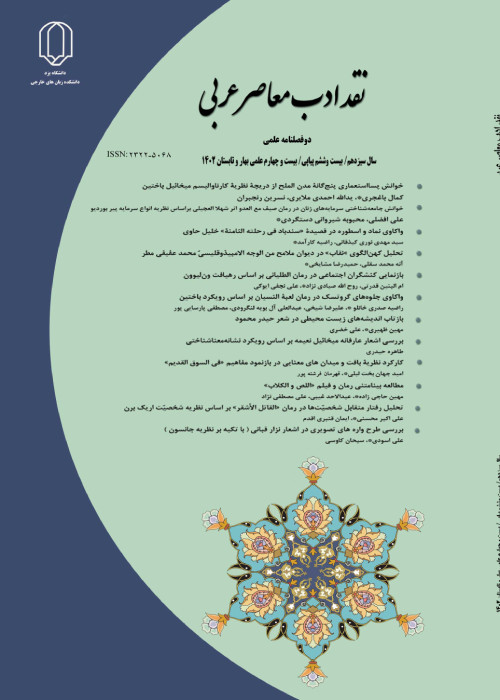Retroactive view of the poem Al-Lufer by Hilma Salim based on Michael Riffaterre's semiotic model
Author(s):
Article Type:
Research/Original Article (دارای رتبه معتبر)
Abstract:
Introduction
Literary semiotics is one of the new methods of literary criticism that examines the semantic system of literary works. Michael Riffaterre is a semiotics theorist who has presented an exact model to provide a suitable tool for literary researchers to study the deep semantic layers of poems. Also, Hilma Salim is a modern Egyptian poet whose critical approach dominates most of his poems. The poem Al-Lufer is one of his critical poems which is full of poetic implications and contains explicit and implicit points about the negative effects of domestic tyranny and Western colonization on the Egyptian people. Based on the findings of Helma Salem's research, he has used a network of poetic symbols within the text to express the main messages in a literary and covered language.Methodology
This research is descriptive-analytical in nature. The data collection is based on the library method, and the research target is The Poem Al-Lufer by Hilma Salim. The approach used in this research is Michael Rifaterre's semiotic model, in which poems are first examined in heuristic and retroactive stages. In the first one, the reader gets a superficial understanding of the meaning of the text, but in the second view, the ungrammatical factors are identified, and the reader can reach the hidden layers of the text through accumulation frames and descriptive associative clusters.Results and Discussion
When the relationship between the outer layer of the text and its depth is found, the connection between the internal and external factors in the unhealthy situation of Egyptians is revealed. The hidden data of the poem show that Westerners and domestic tyrants are the cause of misfortune and terrible situation in Egypt. Negligence and naivety have played a negative role in this case. The poem implies that the secret of the victory of the Egyptians is self-belief, avoidance of relying on the others and public awakening and resistance against tyranny and arrogance. The collections of this ode are in line with its descriptive systems, and each of them expresses different levels of meaning and shows a part of the structural matrix through the process of expansion and description. The collections of the poem are connected in a network, and floating signs are connected to the central signs of the ancient Egypt and the West. Each of the words of the poem is an explicit meaning that the poet loads with many implicit meanings with ungrammatical elements. He also connects the lexical level of the text of the poem to its depth, thus placing an emphasis on synonymy and meaning. Descriptive systems are gathered as a network of intertwined signals based on a virtual relation around the nucleus. According to Riffaterr's theory, the reader relies on his literary ability to move from the lexical level of the text to its deeper layers of the text. The causal relationship between the nucleus and the floating signs forms the semantic structure of this poem. They are connected under a semantic unity, and the linguistic signs in this poem go with this single structure that exists in the whole poem. Once the relationship between accumulations and descriptive systems is discoverd, the hypo grams show the cultural, social, political and economic situation of Egypt. Hypo grams are the key themes that shape the overall picture of a poem in the reader's mind, and some words and phrases evoke them. These themes are not explicitly reflected in the form of specific words, but they are referred to indirectly and visualize the central meaning of the poem in the mind of the audience. These hypo grams provide the basis for reaching the structural matrix of poetry. The structural matrix of this poem, which is rooted in its entire structure, begins linearly with a critical approach to the Westerners and protests against the non-implementation of the people's rule over the people. It ends with the poet's positive and hopeful attitude towards the future of Egypt.Conclusion
According to the Riffaterre model, the relation between the accumulations and the descriptive systems of this poem depicts the structural matrix in which the poet first criticizes the dictatorship of the Egyptian rulers with a retrospective view and then condemns the Western colonial conspiracies and developmental policies. In the end, by arousing the revolutionary feeling of the Egyptians, he calls them to wake up and rise up against oppression and injustice.Keywords:
Language:
Persian
Published:
نشریه نقد ادب معاصر عربی, Volume:12 Issue: 22, 2022
Pages:
205 to 225
magiran.com/p2491255
دانلود و مطالعه متن این مقاله با یکی از روشهای زیر امکان پذیر است:
اشتراک شخصی
با عضویت و پرداخت آنلاین حق اشتراک یکساله به مبلغ 1,390,000ريال میتوانید 70 عنوان مطلب دانلود کنید!
اشتراک سازمانی
به کتابخانه دانشگاه یا محل کار خود پیشنهاد کنید تا اشتراک سازمانی این پایگاه را برای دسترسی نامحدود همه کاربران به متن مطالب تهیه نمایند!
توجه!
- حق عضویت دریافتی صرف حمایت از نشریات عضو و نگهداری، تکمیل و توسعه مگیران میشود.
- پرداخت حق اشتراک و دانلود مقالات اجازه بازنشر آن در سایر رسانههای چاپی و دیجیتال را به کاربر نمیدهد.
In order to view content subscription is required
Personal subscription
Subscribe magiran.com for 70 € euros via PayPal and download 70 articles during a year.
Organization subscription
Please contact us to subscribe your university or library for unlimited access!


